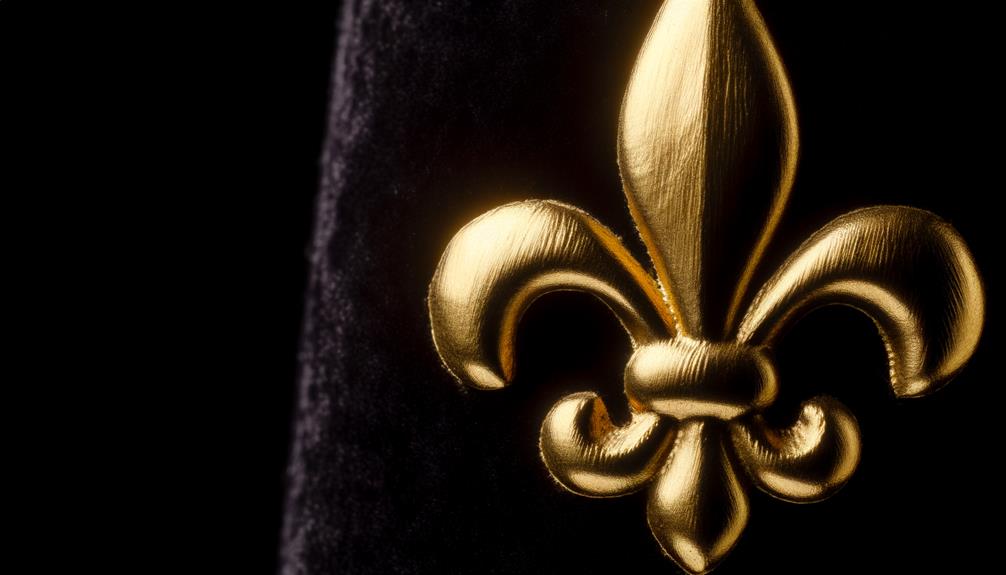What Is the Saints’ Iconic Symbol Called?
The symbol associated with the New Orleans Saints is called the fleur-de-lis, translating to 'flower of the lily' in French. This elegant design features three petals bound together near their bases, rendered often in gold and black to match the team's colors.
Historically, the fleur-de-lis has roots in French royalty and heraldry, symbolizing strength, unity, and tradition. Its deep connection to New Orleans' French colonial heritage enhances its significance.
The symbol carries complex meanings of purity, power, and divinity, making it a versatile emblem in various cultural domains. For a richer understanding of its historical and cultural impact, there's more to discover.

Key Takeaways
- The symbol associated with the New Orleans Saints is called the fleur-de-lis.
- The fleur-de-lis translates to 'flower of the lily' in French.
- It features three petals bound together near their bases.
- The symbol is often rendered in gold and black, matching the Saints' colors.
- The fleur-de-lis reflects New Orleans' French colonial history.
Name of the Symbol

The symbol commonly associated with the New Orleans Saints is the fleur-de-lis. This emblem, a stylized lily, features prominently in the team's branding and is instantly recognizable.
The fleur-de-lis, translating to 'flower of the lily' in French, is characterized by its three petals bound together near their bases. It is often rendered in gold and black, matching the Saints' team colors.
This symbol transcends mere aesthetic appeal; it carries connotations of strength, unity, and tradition. The fleur-de-lis also links to the cultural heritage of New Orleans, reflecting the city's French colonial history.
Its adoption by the Saints serves as a nod to regional pride and the deep-rooted connections between the team and its hometown.
Historical Origins
Rooted in ancient and medieval European history, the fleur-de-lis has long been a symbol of royalty and heraldry. This stylized lily flower traces its origins back to the Merovingian kings of the 5th century, who reportedly used the symbol to signify their divine right to rule.
By the 12th century, the fleur-de-lis became an emblem of the French monarchy, featuring prominently in coats of arms and royal insignia. Its adoption was further solidified during the Crusades, when knights used the emblem as a mark of identification and distinction.
The symbol's influence extended beyond France, appearing in various European heraldic traditions, embedding itself deeply within the continent's cultural and historical fabric.
Symbolic Meaning

Over centuries, the fleur-de-lis has evolved to embody complex symbolic meanings, reflecting notions of purity, power, and divinity. This emblem, traditionally associated with French royalty, has transcended its origins to become a universally recognized symbol.
Its three petals have been interpreted in various ways:
- Purity and Chastity: Often linked to the Virgin Mary, the fleur-de-lis symbolizes purity and virtue.
- Power and Sovereignty: Historically, it has signified the divine right of kings and nobility.
- Spirituality and Light: In religious contexts, it represents spiritual enlightenment and guidance.
The fleur-de-lis's enduring appeal lies in its rich, multifaceted symbolism, making it a powerful emblem across different cultures and epochs.
Design and Usage
Incorporating intricate lines and symmetrical patterns, the design of the fleur-de-lis exudes elegance and timeless appeal, making it a favored motif in heraldry, architecture, and various art forms.
Originating from French heraldry, the symbol is often depicted with three petals bound together by a band. This design is not only visually striking but also versatile, appearing on coats of arms, flags, and building facades.
In architecture, it adorns both Gothic and Renaissance structures, adding a touch of sophistication. Artists and designers appreciate its balanced form, using it in jewelry, textiles, and logos.
The fleur-de-lis has also been adopted by organizations and sports teams, most notably the New Orleans Saints, enhancing its pervasive presence in contemporary culture.
Cultural Impact

The fleur-de-lis, with its rich historical significance and aesthetic appeal, has left an indelible mark on various cultural domains, spanning from heraldry to modern sports. This emblem, originally associated with French royalty, has transcended its origins to become a symbol of elegance and authority worldwide.
Its influence can be observed in several facets of contemporary culture:
- Fashion and Design: The fleur-de-lis is frequently used in luxury branding, jewelry, and interior décor, symbolizing sophistication and heritage.
- Sports: Most importantly, the New Orleans Saints of the NFL have adopted the fleur-de-lis as their team logo, embedding it in the fabric of American sports culture.
- Architecture: This symbol adorns numerous buildings and monuments, enhancing their historical and cultural significance.
Conclusion
The fleur-de-lis, an emblem steeped in historical significance, represents far more than the New Orleans Saints. Rooted in ancient dynasties and religious symbolism, its design conveys nobility, purity, and resilience.
Its widespread adoption in various cultures underscores its enduring legacy. One cannot overstate the profound impact of the fleur-de-lis on art, heraldry, and modern branding.
Truly, this symbol encapsulates a rich tapestry of meanings and applications, intertwining the past with the present in a seamless continuum.





